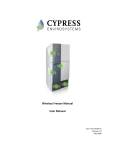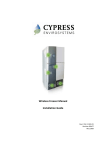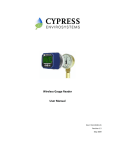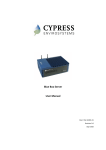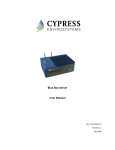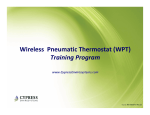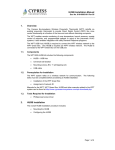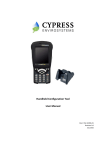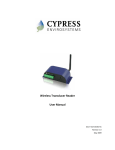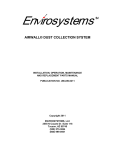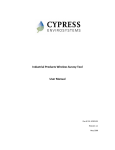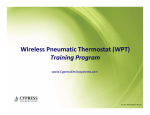Download Wireless Steam Trap Monitor User Manual
Transcript
Wireless Steam Trap Monitor User Manual Doc # 152-10104-01 Revision 1.1 November 2009 Copyrights Copyright 2008 by Cypress Envirosystems, Inc. All rights reserved. The information in this document is subject to change without notice. While reasonable precautions have been taken, Cypress Envirosystems assumes no responsibility for any errors that may appear in this document. No part of this document may be copied or reproduced in any form or by any means without the prior written consent of Cypress Envirosystems. Disclaimer CYPRESS ENVIROSYSTEMS MAKES NO WARRANTY OF ANY KIND, EXPRESS OR IMPLIED, WITH REGARD TO THIS MATERIAL, INCLUDING, BUT NOT LIMITED TO, THE IMPLIED WARRANTIES OF MERCHANTABILITY AND FITNESS FOR A PARTICULAR PURPOSE. Cypress Envirosystems reserves the right to make changes without further notice to the materials described herein. Cypress Envirosystems does not assume any liability arising out of the application or use of any product or information described herein. Cypress Envirosystems does not authorize its products for use in mission or safety critical systems or where a malfunction or failure may reasonably be expected to result in significant injury to the user. The inclusion of Cypress Envirosystems’ product in mission or safety critical system applications implies that the manufacturer assumes all risk of such use and in doing so indemnifies Cypress Envirosystems against all charges. In no event is Cypress Envirosystems liable to anyone for any indirect, special or consequential damages. Table of Contents 1.0 2.0 3.0 4.0 5.0 6.0 7.0 8.0 9.0 10.0 11.0 Introduction ........................................................................................................................ 4 Safety Precautions .............................................................................................................. 4 Description of the WSTM.................................................................................................... 4 3.1 Theory of Operation................................................................................................ 5 3.2 Connections ............................................................................................................ 7 3.3 Sample Collection ................................................................................................... 7 3.4 Cypress Envirosystems Monitoring System ............................................................ 8 3.5 Related Products..................................................................................................... 8 Setup ................................................................................................................................... 9 4.1 Components............................................................................................................ 9 4.2 Installation Overview .............................................................................................. 9 Operation .......................................................................................................................... 10 5.1 Configuration ........................................................................................................ 10 5.2 Turning the WSTM On and Off ............................................................................. 10 5.3 Setting Sampling Rates ......................................................................................... 10 5.4 WSTM Configuration Mode .................................................................................. 10 Care and Maintenance...................................................................................................... 11 6.1 Calibration............................................................................................................. 11 6.2 Battery Life............................................................................................................ 11 Troubleshooting................................................................................................................ 11 Technical Specifications .................................................................................................... 12 Product Disposal ............................................................................................................... 12 Support ............................................................................................................................. 12 Warranty Information....................................................................................................... 12 1.0 Introduction Thank you for purchasing this Wireless Steam Trap Monitor, WSTM. Please read this guide thoroughly before using the WSTM. The WSTM is not a stand-alone product. See Section 3.5, Related Products, for details. 2.0 Safety Precautions • • • Do not immerse the WSTM in water. Always wear personal protective equipment appropriate to the system the WSTM is being installed on. Do not try to repair yourself as it contains no user-serviceable parts. Contact a qualified service technician for repairs. See Section 10.0, Support, for details. 3.0 Description of the WSTM The Cypress Envirosystems Wireless Steam Trap Monitor, WSTM, is designed to monitor the functionality of a steam trap and transmit the data to a PC or data acquisition system. The WSTM has two input channels and is battery powered. Installation is designed to be non-invasive. Figure 1. Wireless Steam Trap Monitor Cypress Envirosystems Doc # 152-10104-01 Rev 1.1 WSTM User Manual Page 4 The following diagram describes the various components of the WSTM. B C F A E D WSTM Front Panel Aux In Aux In Gnd Gnd Batt Out Batt Out Batt In Batt In (Not used) Opt2 (Not used) Opt1 Shield Shield Thermocouple 2 Ch2- Thermocouple 2 + Ch2+ Shield Shield Ch1- Ch1+ Thermocouple 1 - Sensor input terminal strip External power terminal strip LED indicators Function button Radio antenna connector Programming/Expansion port Thermocouple 1 + A. B. C. D. E. F. WSTM Back Panel Figure 2. WSTM Schematic 3.1 Theory of Operation The WSTM monitors steam trap functionality using a proven, time tested method measuring the temperature at the inlet and outlet of the steam trap. Analysis of the steam trap inlet and outlet temperatures, as well as the differential temperature, indicate the functionality of the steam trap. For a properly functioning trap, the inlet temperature will be equivalent to the saturated steam temperature for the operating pressure set point. The outlet temperature of the trap will be equivalent to the temperature of the condensate, typically just under the boiling point of water. Note: Expected steam and condensate temperature are functions of pressure. If the outlet of the trap is under backpressure (e.g. the steam trap outlet is connected to a pressurized condensate tank), the boiling point of water will be higher. Table 1 shows a sample of steam and condensate pressure-temperature correlations. Cypress Envirosystems Doc # 152-10104-01 Rev 1.1 WSTM User Manual Page 5 Saturated Steam Inlet at X pressure Inlet Temperature Approx. saturated steam temperature at X pressure STEAM TRAP Outlet Temperature Less than boiling point of water at Y backpressure Condensate Outlet with Y Backpressure Figure 3. Steam Trap Operation Schematic Saturated Steam Condensate Pressure Temperature Backpressure Boiling Point of Water psig bar °C °F psig bar °C °F 50 3.4 138 281 14.7 1 100 212 100 6.9 164 328 20 1.4 109 228 150 10.3 181 358 30 2.1 121 250 Table 1. Steam and Condensate Pressure-Temperature Correlation Steam traps have two failure modes – failed open or failed closed. Table 2 summarizes the expected temperature profile for the failure modes of a steam trap. Failed open. A failed open steam trap indicates a blown trap that is leaking steam. This failure mode can result in increased energy costs due to the loss of steam. The indicators for this failure mode are: • The steam trap outlet temperature is greater than the boiling point of water, indicating the presence of steam on the outlet of the trap. • The differential temperature between the inlet and outlet of the steam trap is less than the differential for a properly functioning trap. Failed closed. A failed closed steam trap indicates a blocked trap that is building up condensate in the system. Condensate buildup in a steam system can reduce the efficiency of the steam generation system. Additionally, significant condensate buildup can also lead to pipe damage caused by water hammer. The indicators for this failure mode are: • The steam trap inlet temperature is significantly lower than the saturated steam temperature, indicating the presence of condensate on the inlet of the trap. • The differential temperature between the inlet and outlet of the steam trap is less than the differential for a properly functioning trap. Cypress Envirosystems Doc # 152-10104-01 Rev 1.1 WSTM User Manual Page 6 Scenario Inlet Temperature Outlet Temperature Functioning Trap At saturated steam temperature Just below the boiling point of water Blown Trap At or above saturated steam temperature Above the boiling point of water Blocked Trap Below boiling point of water Below the boiling point of water Off or Bypassed Trap Ambient temperature Ambient temperature Table 2. Steam Trap Temperature Profiles 3.2 Connections The WSTM has two pre-defined channels for data collection, and one channel for calculation. • Channel 1 monitors the temperature at the inlet of the steam trap. • Channel 2 monitors the temperature at the outlet of the steam trap. • Channel 3 calculates the differential temperature across the steam trap. The WSTM inputs are pre-configured at the factory and cannot be changed during use. 3.3 Sample Collection Samples are collected one of three ways. Manual instantaneous reading. The user can physically collect a reading at the WSTM. Routine data collection. A routine sampling interval between 1 and 65000 seconds can be programmed into the WSTM. When the WSTM is on, this is the default sampling interval that data will be collected. Pre-programmed short term data collection intervals. Each WSTM comes with two pre-programmed data collection intervals. These are short term intervals of data collection that override the routine data collection rate. They are intended to be used for troubleshooting, or during known events when the user might want to change the sampling rate for a short period of time. See Section 5.0, Operation, for detailed instructions for setting sample collection rates. The reading value is then transmitted wirelessly as part of the overall Cypress Envirosystems Monitoring System. Cypress Envirosystems Doc # 152-10104-01 Rev 1.1 WSTM User Manual Page 7 3.4 Cypress Envirosystems Monitoring System The Cypress Envirosystems Wireless Transducer Reader is part of the Cypress Envirosystems Monitoring System. This system can be setup one of two ways: Figure 4. Cypress Envirosystems Monitoring System Setup Options 3.5 Related Products The WSTM sends data to our Blue Box Server, which stores the data in a SQL server. The WSTM can communicate directly to the Blue Box Server, or through Wireless Range Extenders. Cypress Envirosystems Doc # 152-10104-01 Rev 1.1 WSTM User Manual Page 8 Wireless Steam Trap Monitor (WSTM) Blue Box Server (BBS) Wireless Range Extender (WRE) Figure 5. Cypress Monitoring System Overview 4.0 Setup 4.1 Components The WSTM comes with the following components: WSTM Thermocouples 4.2 External power connector Sensor input connector Installation Overview Installation of the WSTM is designed to be non-invasive to production operations. Mount the unit in close proximity to the steam trap to be monitored. Connect the thermocouple clamps on the inlet and outlet of the steam trap. Connect the inlet thermocouple to Channel 1 of the WSTM. Connect the outlet thermocouple to Channel 2 of the WSTM. Please note, installation of the WSTM must be performed by a qualified technician. For safety reasons, personal protective equipment should always be worn during installation of the WSTM, due to the presence of live steam. Cypress Envirosystems Doc # 152-10104-01 Rev 1.1 WSTM User Manual Page 9 5.0 Operation 5.1 Configuration Configuration of the WSTM must be performed by a qualified technician. See Section 10.0, Support, for details. 5.2 Turning the WSTM On and Off To turn on a WSTM, connect the external power terminal connector. When the device is first powered on, the LED lights will turn on in sequence. To turn off the WSTM, disconnect the external power terminal connector. 5.3 Setting Sampling Rates Manual instantaneous reading. To take a one-time reading, press the Function button for less than 2 seconds. The green LED light will flash to indicate that data has been collected. Routine data collection. Whenever the WSTM is on, it samples based on the routine data collection rate. This rate is between 0 and 65535 seconds, or approximately 18 hours. This value is defined by the user, but can only be changed using the Handheld Configuration Tool. Preprogrammed short term data collection intervals. In addition to the routine data collection rate, there are two pre-programmed short term data collection intervals associated with the WSTM. FAST The FAST sample mode collects data at a 5-second interval for a 5-minute duration. The WSTM can be placed into the FAST sample mode using the Function button. 1. Press the Function button. The green LED will illuminate. 2. Hold the Function button until the yellow LED illuminates. 3. Release the Function button. To cancel the FAST sample mode once it has been initiated, press the Function button. The yellow LED will flash, to indicate that the sample mode has been cancelled. MEDIUM The MEDIUM sample mode collects data at a 30-second interval for an 8-hour duration. The WSTM can be placed into the MEDIUM sample mode using the Function button. 1. Press the Function button. The green LED will illuminate. 2. After two seconds, the yellow LED will also illuminate. 3. Hold the Function button until the red LED illuminates. 4. Release the Function button. To cancel the MEDIUM sample mode once it has been initiated, press the Function button. The yellow LED will flash, to indicate that the sample mode has been cancelled. 5.4 WSTM Configuration Mode The Configuration mode is primarily restricted and for use by qualified service technicians to configure and install the WSTM. The WSTM can be placed into the Configuration mode using the Function button. 1. Press the Function button. The green LED will illuminate. 2. After two seconds, the yellow LED will illuminate. Cypress Envirosystems Doc # 152-10104-01 Rev 1.1 WSTM User Manual Page 10 3. 4. 5. After an additional two seconds, the red LED will illuminate. After an additional two seconds, all three LED lights will flash. Then release the Function button. The green LED light will continuously flash. To exit from the Configuration mode, press the Function button. The LED lights will no longer flash. 6.0 Care and Maintenance 6.1 Calibration The WSTM is calibrated during installation and initial configuration. Routine calibration can be performed and verified by a qualified service technician, but is not required. See Section 10.0, Support, for details. 6.2 Battery Life The battery status of the WSTM can be monitored through the web console. Battery change-out must be performed by a qualified service technician. See Section 10.0, Support, for details. The battery life of the WSTM is dependent on the sampling frequency. Typical ranges are listed below. Sampling Frequency 1 sample per 1 minute 1 sample per 15 minutes 1 sample per hour 1 sample per day Estimated Battery Life 1.5+ years 3+ years 3+ years 3+ years 7.0 Troubleshooting My reading on the web console does not match the transducer display. Please verify that the min and max values were set properly on the Cypress Envirosystems Web Console. If you have any additional problems, please contact us. See Section 10.0, Support, below for details. Cypress Envirosystems Doc # 152-10104-01 Rev 1.1 WSTM User Manual Page 11 8.0 Technical Specifications Steam Trap Compatibility Max Steam Pressure Data Capture Rate Thermocouple Max Thermocouple Length Wireless Frequency Wireless Range Wireless Protocol Approvals Power Supply Battery Life Humidity Operating Temperature Storage Temperature Enclosure Dimensions Weight All mechanical steam traps, 1/2" (12.5mm) steam line and up 800 psi (55 bar) User-configurable Type K, 32°F to 2012°F (0°C to 1100°C) 5ft (1.5m) standard length. Custom lengths available upon request. 2.4GHz Direct Sequence Spread Spectrum, 100mW peak output Up to 1600 ft (488 m), high interference immunity, extendable with repeaters Cypress Semiconductor's highly optimized industrial DSSS radio and protocol. Integrates robust security, antenna and frequency diversity, optional encryption and minimal interference with existing wireless systems (for additional details, please see FAQ at www.cypressenvirosystems.com) FCC Class B compliant, RoHS, ETSI compliant Two 3V lithium batteries >3 years (approximate) 10-99%RH, non-condensing -4°F to 158°F (-20°C to 70°C) -40°F to 185°F (-40°C to 85°C) Rugged extruded aluminum industrial chassis (optional NEMA4/IP66 enclosure) 5.7” x 2.2” x 1.6” (145mm x 57mm x 42mm) 0.51 lbs (230g) 9.0 Product Disposal The WSTM is recycled by Cypress Envirosystems. Contact a service technician or Cypress Envirosystems headquarters to recycle the WSTM. See Section 10.0, Support, for details. 10.0 Support For additional support, including configuration, maintenance, and troubleshooting, please contact us. Cypress Envirosystems, Inc. 198 Champion Court San Jose, CA 95134 +1 888 987 3210 Email: [email protected] 11.0 Warranty Information Every product comes with a full one-year parts and labor warranty. Cypress Envirosystems monitoring of battery status, product status, and potential communications packets are included during this period, so that proactive service can be provided to our customers. Cypress Envirosystems Doc # 152-10104-01 Rev 1.1 WSTM User Manual Page 12













